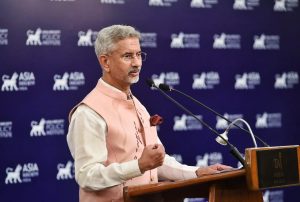Few — if any — Indian foreign ministers have enjoyed as much influence and free rein as External Affairs Minister Subrahmanyam Jaishankar. So when Jaishankar speaks about Indian foreign policy, it’s often worth some analysis.
In New Delhi this week, Jaishankar reiterated some of his tenets once more at the launch of the Asia Society Policy Institute’s local chapter. The speech laid out how Prime Minister Narendra Modi’s government sees Asian geopolitics — highlighting some significant points of difference with both China and the United States.
Superficially, folks in Washington will enjoy much of what Jaishankar had to say. He reiterated the importance of the Quad as a forum that makes up for Asia’s “lack [of] an agreed architecture” to meet “challenges that go beyond the remit of [the ASEAN’s] institutions and platforms.” He also talked of the U.S. and Australia as powers that have “legitimate interests” in the region.
He even took a subtle dig at China on several levels — talking about “adherence to laws, norms and rules,” arguing that connectivity initiatives (such as Beijing’s Belt and Road Initiative) ought to be “transparent, viable and market-based,” and calling for adherence to “agreements and judgments” (such as the international tribunal ruling on the South China Sea).
Yet, despite the use of language that would please Washington, India’s worldview hardly looks like America’s. In some sense, it, in fact, sounds more like China’s.
Jaishankar began his speech by emphasizing the need for multipolarity from the viewpoint of accepting Asia’s vast diversity. This is not new for Indian diplomatic rhetoric but it is made more significant by recent trends.
Ever since U.S. President Joe Biden brought to office an explicitly values-based foreign policy and rhetoric on human rights, the Modi government has been at odds with the West over India’s own backsliding on human rights values. New Delhi has countered criticism by arguing that the West should not comment on India’s “internal affairs” and that India is “not looking for their approval” — language that is eerily similar to Beijing’s.
Seen in that context, far from Biden’s efforts to build a coalition of democracies to wage war on autocracy, New Delhi’s multipolar world order would be accommodating of these differences — “distinct regions, specific cultures” as Jaishankar put it.
Not by coincidence, despite speaking at length about China both directly and indirectly, Jaishankar made no mention of many of America’s key concerns, whether Taiwan, Xinjiang, Hong Kong or trade. Instead, he boiled down all of India’s worries about China to just one factor: “the state of the border will determine the state of the relationship.”
That statement reveals a now long-open window of opportunity for Chinese President Xi Jinping if he wants to take it: make significant concessions on the border and pull India away forever from Washington’s system of alliances. Indeed, strategically speaking, no concession on the border is likely to be costly enough for Beijing to offset the benefits of a rapprochement with India.
Like most Asian nations, India doesn’t count itself as an ally of either China or the U.S. Instead, it wants to see a healthy balance of power between the two world powers — ultimately hoping to contain each other’s hegemony and dilute their unilateral influence. For the Modi government, the Quad, the focus on multipolarity and the delicate dance between Beijing and Washington are all merely means to that end.

































